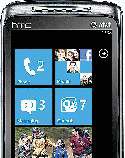Microsoft’s app phone has promise, problems
Published 5:00 am Thursday, October 28, 2010

- The HTC Surround uses Windows Phone 7, which features an innovative interface that's fast and easy to use. But it's also lacking some basic functions.
What on earth is Microsoft doing, bringing out its iPhone competitor now, in 2010?
Doesn’t it realize that Apple has a three-year, 70-million-phone, 300,000-app head start? And that Google’s Android phone software has a two-year, estimated 30-million-phone, 100,000-app head start?
And does Microsoft really think that the world needs yet another black rectangular multitouch app phone design?
Well, clearly, the answer to the last question is yes. Windows Phone 7 is new software that Microsoft hopes will run on new phones from various manufacturers and cellular networks. I tried it out on the nearly identical Samsung Focus (AT&T), HTC Surround (AT&T) and HTC HD7 (T-Mobile). Each will go on sale in the coming weeks for $200 (with two-year contract).
The name “Windows Phone 7” is misleading twice.
First, it’s not Windows. It doesn’t look or work like Windows, doesn’t run Windows software, doesn’t even require a Windows PC. (There’s an iTunes-like program for loading the phone with music and videos, but it’s available for both Mac and Windows.)
Second, this is not “7.” That number implies some relationship to Windows Mobile 6.5, Microsoft’s latest phone software attempt, which is corporate, cramped and complicated. No, Windows Phone 7 is most definitely a 1.0 release.
That may sound like a slam. But “1.0” can mean “unfinished” as well as “a fresh start loaded with innovations.” So while Windows Phone 7 shows some real genius, it is missing an embarrassingly long list of features that are standard on iPhone and Android. Ready?
There’s no copy and paste. No folders for organizing your apps. No way to add new ringtones. No way to send videos to other phones as MMS messages. No video chat. No front-facing cameras.
And there’s no multitasking. You can play your own songs while working in other programs, but you can’t listen to, say, Pandora Internet radio.
Sound familiar? These are precisely the features that were missing from iPhone 1.0, too. Furthermore, there’s a search button, but it can’t search your whole phone at once (for apps, contacts and e-mail simultaneously, for example). There’s no visual voice mail. And there’s no tethering option (where you pay an extra $20 a month to use the phone as a glorified Internet antenna for your laptop).
Like the iPhone, the Web browser doesn’t play Flash videos on the Web — but it also won’t play the HTML5 videos that the iPhone plays, or even videos in Microsoft’s own Silverlight format. So, no YouTube, no Hulu, no online news videos.
Here’s the thing: WP7 is a 1.0 release in a good way, too. It’s a complete rethinking of app phone software design. Somehow, Microsoft has pulled off the inconceivably difficult task of coming up with a fresh, joyous, beautiful new software design that doesn’t look anything like iPhone or Android.
The WP7 home screen doesn’t have evenly spaced app icons on multiple side-by-side home screens, like Android or iPhone. Instead, you see two columns of scrolling, multicolored rectangular tiles. Each represents an app, a speed-dial person, a favorite Web page, a music playlist — whatever you want to put there. They’re easy to rearrange, organize and remove. (Thank goodness. Microsoft lets cell carriers, like AT&T or T-Mobile, install their own junkware. At least you can delete it on Day1.)
These big, finger-friendly tiles are also informative. A number on a tile tells you how many voice mail messages, e-mail messages or app updates are waiting. The music tile shows album art, the calendar tile identifies your next appointment, and so on.
Other fresh, clever ideas abound. On any WP7 phone, there’s a dedicated camera button — and you can take pictures even when the phone itself is turned off, a fantastic feature. You can set up the phone so that it automatically uploads your photos to Facebook or Microsoft’s SkyDrive as you take them.
You can speak to dial, search Bing.com or open apps. Unfortunately, you can’t speak to type, as you can on the iPhone (with the free Dragon Dictation app) or Android (built-in).
Several apps are “hubs” — more ambitious, multiscreen programs, like Pictures, People or Office. How do you know that you can swipe to view the next panel? Because you see the edge of the next “page” peeking out from the edge of the screen. Clever.
Even the lock screen has been visited by the Good Idea Fairy. Without even fully waking the phone, you can see the date and time, your next appointment, and how many new messages await (e-mail, voice mail, texts).
Microsoft dictates minimum hardware specs to the companies making WP7 phones, so they’re rocket fast. The software responds to your touch fluidly and effortlessly, with animated flourishes that never get in your way.
Battery life is another story. As with similar phones, you’ll have to charge these early WP7 phones every night.
It’s amazing that Microsoft pulled off the hard part: It created a truly fresh approach to managing an app phone’s 17 gazillion features that’s fun to use, crisp and attractive.
Obviously, Microsoft still has a lot of work to do, and it will be a long time before its store offers a decent selection of apps. The company intends to deliver free software updates as it fills in the holes. In other words, for now, this may not be the phone you’ll want to buy.
But it’s definitely a phone you’ll want to watch.






